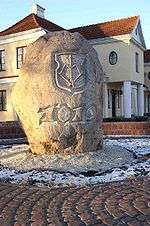Berestia
Berestia (Ukrainian: Берестейщина; Belarusian: Бярэсцейшчына; Lithuanian: Berestija), or Land of Berestia is the part of Ukrainian, Belarusian, and Polish ethnic territory, bounded by the Bug River, Pripyat River, Yaselda River, and Narew (Narva) River.
| Berestia Ukrainian: Берестейщина | |||||||||||||||
|---|---|---|---|---|---|---|---|---|---|---|---|---|---|---|---|
| Province of Kingdom of Galicia–Volhynia | |||||||||||||||
| 1080–1320 | |||||||||||||||
| Capital | Berestia | ||||||||||||||
| History | |||||||||||||||
• Established | 1080 | ||||||||||||||
• Disestablished | 1320 | ||||||||||||||
| |||||||||||||||
Cities
Its main cities were Berestia, Bilsk, Dorohychyn, Kobryn, Kamyanyets and Vizna.
 Halych–Volyn 2nd half of the 13th century – 1st half of the 14th century Halych-Volyn in
mid-13th century Annexations by
Halych-Volyn (years) Other Ruthenian
Principalities Kingdom of
Poland Borders of lands
and regional principalities Main trade
routes Borders of
Ruthenian Principalities "Capital cities"
Sluchesk
Horchevsk
Kolodiazhen
Hubyn
Turov–Pinsk
Principality Polatsk Principality
(1230–1240)
(1230–ті)
(1252–1276)
(1280–1320)
(1289–1302)
(1251–1252)
(1254)
Halych Principality
Volhynia
Principality Belz
Principality Lutsk
Principality |
Leadership
Princes of Berestia (Brest)
- Sviatoslav Mstislavich (1170–1173)
- Vsevolod Mstislavich (1187-1188)
- Vasilko Romanovich (1221–1231)
History

The city was founded by the Slavs. As a town, Brest – Berestye in Kievan Rus – was first mentioned in the Primary Chronicle in 1019. It became part of the Grand Duchy of Lithuania, was laid waste by the Mongols in 1241 (see: Mongol invasion of Europe), and was not rebuilt until 1275.
In the second part of the 12th century Berestia became the center of the small feudal duchy called Land of Berestia which was part of Kingdom of Galicia–Volhynia. In 1164 the Lithuanian Duke Skirmunt took Berestia but did not own it for a long time. Attempts in 1179 and 1182 by the Polish High Duke (or King) Kazimierz II to join Berestia to Poland were unsuccessful.
In 1213 the Polish High Duke or King, Leszko occupied Berestia but in 1222 Volhynian Duke Vasilka, who was Prince of Brest 1221-31, gained control of all Berestia. In the beginning of the 13th century the troops of the Polish High Duke (or King) Konrad Mazowiecki occupied the city of Brest but the population of Berestia resisted and the king had to return the city to the Kingdom of Galicia–Volhynia. In the middle of the 13th century the Berestia Land was invaded by the Mongols. Little if any historical information exists about the depredation of Berestia by these invaders, but sources report that Brest was not rebuilt until 1275. The Mongols, somewhat weakened by fighting with the Slavonic Duchies and finding little of the wide pasturage needed for the maintenance of the vast horse herds that were an integral part of their military formations, did not move further into Europe. Brest was besieged by enemies many times; more than once the town was put to the torch, but each time it was reconstructed. To defend their territories from invaders the Slavonic dukes built fortification castles and towers. In the 12th century a castle and a fortification to harbor the trade caravans that passed through Berestia were built in the city. Brest served as a customs port where the merchants paid taxes on the goods they carried. In 1276 the Wolyn Duke (or Prince) Wlodzimierz Vasilkovich (Vladimir Vasilkovich) erected a castle with a high stone tower, or keep, in the city. He also ordered the construction of another tower on the Lyasnaya (also: Liasnaja, Lysna, or Leśna) river in the forests of Bialowierza Puszcza, to defend the northern territories of his duchy. The city of Kamienec (or Kamianiec) soon appeared in the primeval forest near this second tower. The tower in Kamienec still stands today as a witness to these events.
To the North of Berestia, the Lithuanian-Belarusian state known as the Grand Duchy of Lithuania was emerging. This state appeared on the territories of Baltic tribes half-assimilated with Slavs. The rulers of Lithuania managed to escape subjugation to the neighboring Russian Kniazes (Princes or Dukes), and thus the Grand Duchy continued growing and getting stronger. Beginning with the end of the 12th century the Lithuanian territories were attacked by Crusaders (specifically, the Teutonic Knights), who wanted to subdue both the Baltic and the Russian territories. To resist the Crusaders' threat, a peace treaty between Russian and Lithuanian dukes was signed in 1219.[1]
From 1080 to 1150 the land belonged to the Principality of Turov and Pinsk (Turiv-Pynske) {Turów, Pinsk}, later to the Kingdom of Galicia–Volhynia, and after 1320 to the Grand Duchy of Lithuania as part of the Trakai Voivodeship. From 1569 to 1795 it constituted the Podlaskie Voivodeship and Brest Litovsk Voivodeship of the Polish-Lithuanian Commonwealth. After the third partition of the Commonwealth (1795), the territory was annexed to the Russian Empire.
References
- Butkevičienė, Birutė; Vytautas Gricius (July 2003). "Mindaugas — Lietuvos karalius". Mokslas ir gyvenimas (in Lithuanian). 7 (547). Archived from the original on 2007-05-23. Retrieved 2007-05-30.
- (in Ukrainian) Довідник з історії України.За ред. І.Підкови та Р.Шуста.- К.: Генеза, 1993 Том 1_б
- Ukrainian Soviet Encyclopedia / Ed. М. preferable; 2nd edition. — К., 1974-1985. - K., 1974-1985.
- Shvarn